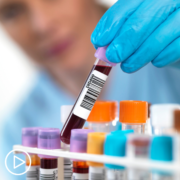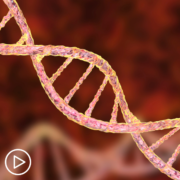What Are Essential Genetic Tests for Metastatic Breast Cancer Patients?
What Are Essential Genetic Tests for Metastatic Breast Cancer Patients? from Patient Empowerment Network on Vimeo.
Genetic tests can help guide metastatic breast cancer care. Dr. Julie Gralow discusses essential genetic tests for metastatic breast cancer, and how results impact treatment decisions.
Dr. Julie Gralow is the Jill Bennett Endowed Professor of Breast Medical Oncology at the University of Washington, Fred Hutchinson Cancer Research Center, and the Seattle Cancer Care Alliance. More about this expert here.
See More From INSIST! Metastatic Breast Cancer
Related Resources:

How Genetic Mutations Affect Metastatic Breast Cancer Disease Progression and Prognosis |

|

What Could Metastatic Breast Cancer Genetic Testing Advances Mean for You? |
Transcript:
Katherine:
For a patient to get diagnosed, what are the essential tests?
Dr. Gralow:
So, we’re talking about metastatic breast cancer here, and in the U.S., maybe up to 10% or slightly less of breast cancer is technically Stage 4 or metastatic at diagnosis. That means at the time we first found it in the breast, it had already spread beyond. So, an important thing that we’ll do with a newly diagnosed breast cancer is especially if there are a lot of lymph nodes are involved or the patient has symptoms that might say there’s something in the bone, liver, or lung is staging.
So, we’ll use scans – maybe a CAT scan, bone scan, or PET scan – and we will look at whether the disease has gone beyond the breast and the lymph nodes, and if so, where. So, maybe 8-10% of breast cancer diagnosed in the U.S. already has some evidence that it has spread beyond the breast, but the most common way that metastatic breast cancer happens is that a patient was diagnosed possibly years and years ago, treated in the early-stage setting, and now it comes back, and that is the most common presentation for metastatic breast cancer, and sometimes that can be due to symptoms.
As I said, if it comes back in the bone, maybe that’s bone pain. If it’s in the lung, it’s a cough. There are symptoms. Sometimes, it’s because we’ve done a blood test or something and we find some changes there.
And so, when a breast cancer has recurred, it’s really important to document that it’s really breast cancer coming back, first of all, and so, if we can, we generally want a biopsy, and we want to stick a needle in it if it’s safe to do, and look and verify that it looks like breast cancer, and also, it’s really important that we repeat all those receptors that we talked about from the beginning because it can change.
So, a cancer up front 10 years ago could have been positive for estrogen receptor, but the only cells that survived – mutated, changed – were estrogen receptor negative, so what comes back could be different. So, it’s really critical to get that biopsy, repeat the estrogen/progesterone receptor and HER2, and also, in an ideal world, now that it’s 2020 and we’re moving more toward genomics, to do a full genomic profile and look for other changes and mutations that could drive our therapeutic options.
So, staging, knowing where the cancer is, getting a good baseline by understanding where it is and how big it is so that we can follow it and hopefully see that it’s responding to treatment, and then, repeating all of the biology components so that we know what the best options are for treatment are really critical.
Katherine:
Right. How can patients advocate for a precise breast cancer diagnosis, and why is that important?
Dr. Gralow:
Well, all those things I just mentioned are key. Knowing exactly where it is so that we can monitor it – for example, if the cancer has come back in the bones, we would add what we call a bone modifying agent, a drug like zoledronic acid or denosumab – Zometa or Xgeva – which can suppress bone destruction from the cancer, but if it’s not in the bone, we wouldn’t add that.
And, we want to have a good look everywhere so that we can see if it’s responding because sometimes, the tumor can respond differently in one area than another. Also, I think it’s really important to know what your treatment options are by doing that biopsy, getting a full panel, and looking at potentially hundreds of genes that could be mutated, deleted, or amplified so that we know what our treatment options are.
And, we’re not going to use all the treatment options up front, so it’s helpful for knowing that if this treatment doesn’t work or is too toxic, what are the second-line or third-line options? So, we make sure that there’s what we call good staging up front so we know where the cancer is, and then we make sure that we’ve looked at it as best we can in 2020 with all the genomics.
That would give us the best chance of being tailored – individualized – to the tumor. Sometimes, if we can’t biopsy it, like with a needle that would go into a liver spot, then increasingly, we’re looking at what we call liquid biopsies, and that can be drawing the blood and seeing if we can find parts of the tumor, whether it be the DNA or the RNA that’s floating around in the blood, and sometimes we can get that information out of the blood as well.









